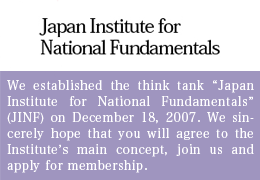Beware the Resurgence of Ming Imperialism
With the upper house election slated for July 21, there have been frequent predictions that the voting rate will be extremely low. One reason appears to be that a large percentage of voters expect the results to be the same even if they do not vote, as the incumbent Liberal Democratic Party (LDP) and its coalition partner Komeito Party easily dominate the opposition parties.
There is a book I particularly wish to recommend at this time to those who are thinking along these lines – the somewhat voluminous Monsoon: The Indian Ocean and the Future of American Power (Random House, 2010) by Robert D. Kaplan. This book is engaging in terms of America’s position in this region, but also provides insight to a host of serious issues facing Japan.
After coming to grips with what Kaplan has to say about the dynamic evolution of the 21st century world, I believe it should be quite clear to the reader why it is not a good idea to refuse to go to the polls, or cast a protest vote for such a splinter party as the Japan Communist Party. It will also become crystal clear that Japan will truly find itself in a dangerous position should it fail to correctly comprehend the nature of our contemporary chaotic world.
The balance of power of the world has shifted significantly, the Pacific Ocean – especially its western half, i.e., the half bordering on East Asia – and the Indian Ocean having replaced the Atlantic Ocean as the center stage of international politics. An era is steadily approaching in which a cluster of nations in the Pacific and Indian Oceans – such as Japan, India, and China – will be expected to play a bigger role in place of the United Nations, in which nations such as France, which no longer exercise their once strong influence, had long remained dominant as members of the Security Council.
Under such circumstances, it is vital for the voter to determine which party proposes a sound strategy aimed at securing a stable future for Japan. After the voter becomes convinced that he or she has a clear view of which party is capable of delivering the goods in terms of Japan’s future world strategy, the next step is to equip that party with the power to implement its strategy by making his or her vote count alongside that of many others. After all, only when the country is managed by a stable and strong leadership can Japan’s future be secured in the turbulent arena of international politics. I wish to urge the reader to view the map of the world with this frame of mind. The voter doesn’t want to make a choice that will put Japan on a road to decline, leading to a total collapse. Thinking in this fashion will help clarify the weight and significance of one’s vote.
The “Malacca Dilemma”
The first section of the translated version of Kaplan’s book, published in Japan in July 2012 by Intershift Co., is headlined: “The World after the US.” The author depicts the increasingly fierce struggle between China and India – the two nations that will be the key players of the multipolar 21st century world – by first making an intriguing reference to China. Kaplan notes that the Chinese have begun a “well-heeled, very public commemoration of the historical figure of Zheng He”― a legendary Chinese admiral of the Ming Dynasty in the 15th century.
Zheng (1371-1433) hailed from Yunnan. His father was a Muslim who swore allegiance to Mongolia. Zheng was a eunuch, captured and castrated as a little boy for service in the Forbidden City. Winning the confidence of Emperor Yongle (the third ruler of the Ming dynasty), Zheng rose up through the ranks, eventually being appointed as an admiral in the Chinese navy. He is said to have led his fleet of hundreds of ships on a total of seven expeditions, visiting the east coast of Africa, the Middle East, and a number of locations in the Asia-Pacific. Some of the expeditions were said to have sailed with as many as 30,000 men.
In a nutshell, Zheng He’s accomplishments comprised a promotion and propagation of Sinocentrism. His approach was effective in implementing a world strategy aimed at making the nations in a wide expanse of Asia, the Middle East, and Africa tributaries of China, with China serving as the suzerain. Japan, too, was briefly a tributary of China during the Muromachi period (1333-1573), when Yoshimitsu Ashikaga paid tribute to the Ming court, a sorry blemish in the history of Japan. It was at about this time that Zheng He flourished.
Kaplan explains why the Chinese are commemorating Zheng He so enthusiastically:
“China’s much renewed emphasis on this Indian Ocean explorer and his life’s story says, in effect, that these seas have always been part of its zone of influence.”
The strategic object of the current Chinese leadership – “realization of a great revival of the Chinese nation” – can be construed as meaning China is determined to reproduce the Chinese sphere of influence once developed during the Ming and Qing dynasties. Zheng He led his expeditions across the Pacific Ocean to the Indian Ocean. Contemporary China is avidly trying to develop a similar but new sphere of influence extending from the Pacific into the Indian Ocean. The first vital key in this Chinese strategy is the control of Taiwan. Kaplan introduces the subject in this way:
“(Former) Chinese President Hu Jintao, according to one report, has bemoaned China’s sea-lane vulnerability, referring to it as his country’s ‘Malacca dilemma,’ a dependence on the narrow and vulnerable Strait of Malacca for oil imports from which China must somehow escape.”
There are two ways to overcome the “Malacca dilemma” – securing maritime transportation routes or constructing ports that will allow China to reach the Indian Ocean by land, both of which the Chinese are already working on. In this context, a concrete measure for China would be to take over Taiwan, which is crucial, as it would turn the South China Sea into a virtual inland sea for China, inevitably allowing it to incorporate the peripheral nations of the South China Sea and the Malacca Strait into a Chinese sphere of influence.
Another concrete measure for China to secure maritime transportation routes would be development of the Kra Isthmus – the narrowest point of Thailand on the Malay Peninsula. That China has a grand strategy to construct a canal there has repeatedly been discussed. If the construction materializes, it would become possible for China to reach the Indian Ocean directly by land, which would instantly strengthen China’s naval power significantly. The projected canal, if and when completed, would impact the world with the same intensity as was experienced when the opening of the Panama Canal in August of 1914 completely altered 20th century international geopolitics.
“The World after the US”
Another method for China to resolve the “Malacca dilemma” would be a construction of ports that it would use at will in a host of nations around the Indian Ocean. In point of fact, China has already taken the lead in constructing ports deep enough to berth large warships in countries like Myanmar, Bangladesh, Sri Lanka, and Pakistan.
Noting that the Indian Ocean is the most interesting ocean on the globe when one ponders “the world after the US,” Kaplan further explains: “Forty percent of seaborne crude oil passes through the Strait of Hormuz at the one end of the ocean, and 50 percent of the world’s merchant fleet capacity is hosted at the Strait of Malacca, at the other end…making the Indian Ocean the globe’s busiest and most important interstate.”
China’s ability to manipulate the Indian Ocean at will while having conspicuously raised its international status – as if the old Chinese empire has been recreated ― is mainly a reflection of its concerted efforts to build up its naval power far more vigorously than any other nation on earth. Notes Kaplan: “Indeed, China is in the midst of a shipbuilding and acquisition craze that will result sometime in the next decade in the People’s Liberation Army Navy having more ships than the U.S. Navy…”
Such an observation does not mean that the supremacy of the US Navy will be lost immediately. However, the US no longer enjoys a monopoly of naval power. Reflecting such a shift in military power, the US will have no choice but to seek cooperative relations with China on all fronts while competing with the communist nation.
It is such an intricate international situation that Japan finds itself in at this juncture, making it all the more necessary to strive hard in order to survive as a stable democracy. Which of the parties offer the most responsible answers to the host of critical problems facing Japan? Pondering these questions while reading Monsoon will help expand one’s mind. One then should be able to more vividly perceive the true qualities of each of the parties, gaining a greater impetus to go to the polls on July 21.
(Translated from “Renaissance Japan” column no. 566 in the July 18, 2013 issue of The Weekly Shincho)








